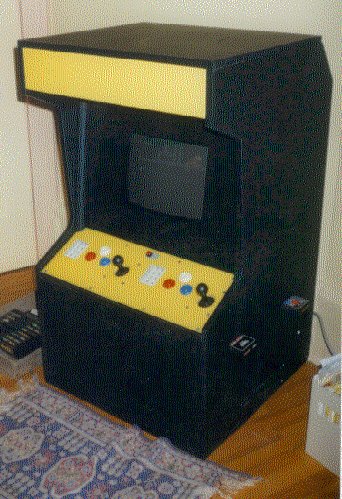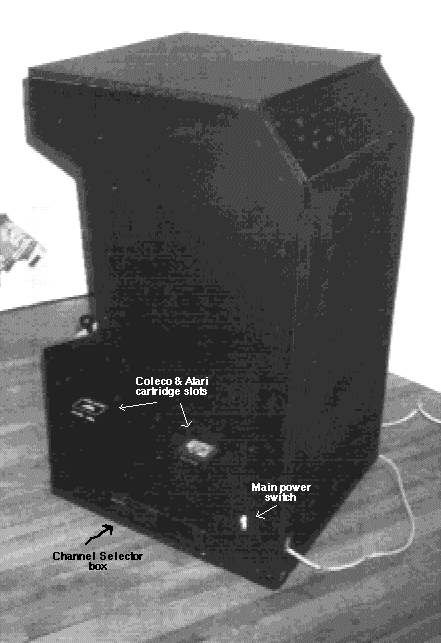Brent's Consolecade
Hello....
My "consolecade" is done and the photos have been devoloped and scanned. Sorry for the quality. I only have an old black and white hand scanner at the moment. You've received this message either becuase you requested to see some pictures of my consolecade, or I've been talking to you about it and said I would send you some pictures when they were ready. Sorry, I don't have a web page to post these, so I have to e-mail them. If anyone wants to put them on a web page, I'd be more than happy about that...just let me know.
The consolecade is a 'stand up' arcade style cabinet, which I built myself entirely from scratch. It houses a ColecoVision circuit board and an Atari 2600 circuit board. Yes, it would have been great to have made a MAME cabinet, but I don't have a spare 486 lying around with Multisync monitor. I did however have several Commodore composite monitors and many classic gaming consoles which were boxed up...so I came up with this project.
The pictures lack colour, but the real cabinet is black and yellow. I am trying to find decals for the sides and marquee, so if you know of any, I would appreciate hearing about it.
The cartridges are inserted through slots on the side of the cabinet. A main power switch is also on this side (the right side). I tried doing seperate video hacks on the circuit boards of both video games, but it didn't work on the ColecoVision (I followed the ColecoVision FAQ instructions)...so instead I used the RF video outs on each system and use the cable convertor box (channel selector) as an RF demodulator (it has seperate audio/video outputs on it which feed the Commodore monitor).
What you don't see in any of these scans is the left side panel of the cabinet. It has switches which allow one to select which video game system you want to activate....it also has a switch so that either the video from the ColecoVision or the 2600 goes to the monitor. There was also a conflict problem with the ColecoVision when the arcade controls were hooked up to both the 2600 and the ColecoVision at the same time (even when the Atari 2600 was powered down) whereby the Coleco would think that all directions and buttons were being pressed simultaneously. I tried using diodes to fix this, but it resulted in problems for the 2600...so I ended up mounting another switch on the left side, which would allow the user to select which system the arcade controls should work with.
When I first started this project...all I wanted was to mount an Intellivision in a cabinet. It would have worked, too, but for those darn 16 directional controllers. You need to have three seperate pins grounded on the controller for a simple 45 degree diagonal movement. If you only ground two, as in any normal 8 directional joystick, you get directions like NNE, SEE, SSW and NWW....or something like that....it was hell...and so I decided to go with a ColecoVision and Atari. Anyway....that's why you see THREE arcade buttons for each player...the Intellivision has three seperate action buttons on each controller.
The ColecoVision uses two of these buttons, and the Atari only uses one of course....actually though, I have the white (top) buttons wired up to act as the GAME SELECT switch of the Atari....so you can flip through game variations by pressing this button. I don't mind having extra buttons, though. If I ever do decide to add a MAME computer, it will be able to use these buttons. The central red, small square button acts as a reset button for both the Atari and the ColecoVision.
The Colecovision also uses the two touch tone telephone keypads mounted into the control panel for game select and special functions. I had to heavily modify these keypads internally to get them to work with the ColecoVision....what you don't see is that under the control panel are two circuit boards from actual ColecoVision controllers....the buttons, keypad and joystick are wired into these. I decided to use the actual circuit boards from real Coleco controllers becuase of the complex array of diodes the Coleco controllers have.....it would have been a lot of work to reproduce these arrays.
The control panel is plexiglass backcoated with yellow paint and a reinforcing wood layer hidden below it. The monitor is hidden behind a black panel with a hole to expose only the CRT....on top of this black panel is a tinted plexiglass sheet. So when the machine is off, you really can't see the darkened monitor very easily.
Also under the marquee is a concealed speaker and a volume knob.
I didn't find out about Sean Kelly's "Classicade" until shortly after I started designing an "intellivision in a cab", but, I must say that I was given a great deal more inspiration to do this once I saw Sean Kelly's "Classicade"...although he was a little more sensible in using an actual arade cabinet instead of building one (next time I'm buying an old cabinet....it's easier and probaby costs the same). I think his "Classicade" has more consoles in it, but I'm not sure if they are all hooked up to the arcade controls (i.e. I can't see any keypads that the ColecoVision would use - so I'm not sure how he does it - care to comment Sean?).
I would have chosen to mount a 7800 circuit board rather than a 2600, but I simply hardly ever come across a 7800 and so have none in my collection. I also though about mountin a NES....but in my area NES carts still cost about 5-6 bucks at flea markets ($3 rarely)....and I like the older systems anyway.
Oh...and you've probably noticed that my "Consolecade" is only about four feet high. This was actually by design. I wanted it to be somewhat more portable than an actual arcade cabinet (although it wieghs in at about 100 lbs!)....my plan is to put it on a strong table, or filing cabinet which will hold the cartridges of the two systems....but as it is it's great for young children - perfect height!
So there you have it. A poor man's MAME cabinet. Actually, the ColecoVision ports of games like Pepper II, MouseTrap, Ladybug, Donkey Kong, Venture etc....are pretty darn close to the arcade versions, and play very well in this setup. I also like older games like Missile Command, Berzerk, Outlaw, etc...and the Atari 2600 versions are pretty good. Even later Atari releases like Jr. Pacman, Galaxian, Millipede, etc retain a lot of the feel, if not the graphics.....
If anyone has any comments or questions about this monsta, please feel free to ask....I've been so obsessed with it lately I'm glad it's done, but I'd love to blab about it....
Here is a list of the knobs on it:
Left Side panel: Power select for Atari or Coleco
Video select for "" "" ""
Controller select for "" ""
Front Panel: Volume knob (under marquee)
reset button
Two joysticks
Two phone keypads
Two sets of three arcade buttons.
Right side panel: Main power on/off
Cartridge slots
channel selector box (RF demodulator)
Take Care!
---------------------------------------------------------------------------
|//\\//\\//\\//\\//\\ Brent Santin - Ontario Canada //\\//\\//\\//\\//\\|
* student of wind instrument making * gravy-o-tron * wooden flute player *
---------------------------------------------------------------------------
Brent's Consolecade Pictures





